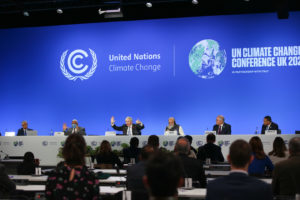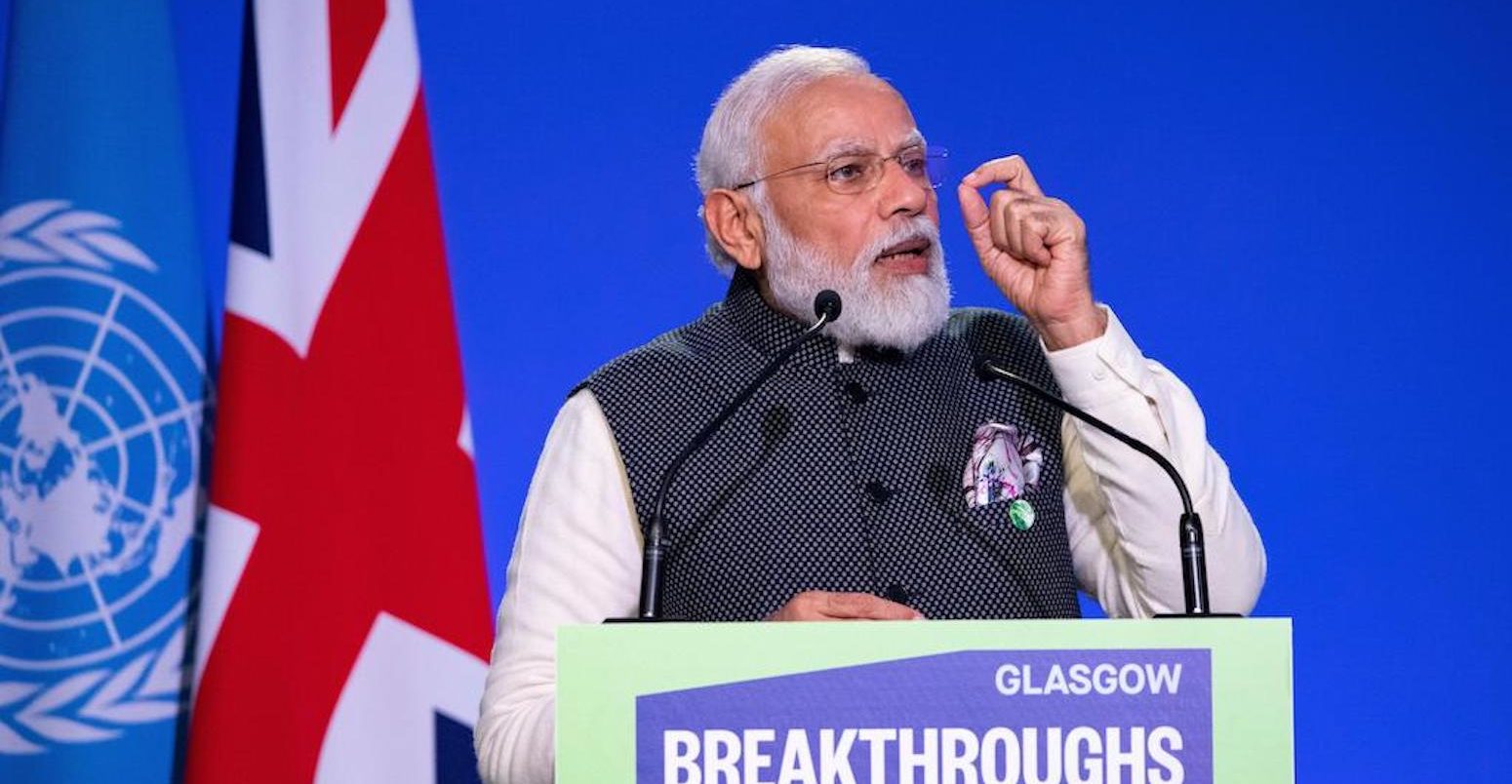
Q&A: What does India’s updated Paris Agreement pledge mean for climate change?
Aruna Chandrasekhar
09.14.22Aruna Chandrasekhar
14.09.2022 | 8:00amIndia’s government has, following a long delay, finally submitted an updated climate pledge under the terms of the Paris Agreement.
The new four-page document, which was published on 26 August, arrives two years after the original deadline – and two months before the upcoming UN climate summit COP27 in Egypt.
The world’s third-biggest emitter has committed to reduce the “emissions intensity” of its gross domestic product (GDP) to 45% below 2005 levels by 2030. India’s pledge is an update to its first nationally determined contribution (NDC), submitted in 2015, which targeted a 33-35% cut.
It also includes a commitment that around half of its installed electricity generating capacity will be made up of non-fossil fuel sources by 2030. However, this is conditional on the transfer of technology and finance from other countries.
Three weeks earlier, the Indian government announced that its cabinet had approved the update, thus “translating” the goals set out by prime minister Narendra Modi when announcing his nation’s net-zero by 2070 target at COP26 in Glasgow.
But the government is still yet to submit a long-term strategy that captures its decarbonisation plans and reflect its 2070 net-zero target, something it says it plans to do “in coming months”.
Experts and commentators have cautiously welcomed the update, with some saying that India was committing to more than its fair share of the effort required to limit warming. However, others have said it still needs “further cuts” to keep the world on track for the 1.5C target.
Below, Carbon Brief reviews India’s new climate plan and the implications for the nation’s energy sector and emissions, as well as its recently introduced policies and the challenges it faces in tackling climate change.
- What is in India’s updated climate pledge?
- Do India’s new climate pledges raise its ambition?
- What do India’s pledges mean for its energy and land-use sectors?
- What are the political considerations behind India’s new climate plan
- How have India’s new pledges been received?
What is in India’s updated climate pledge?
India’s 2030 pledge under the terms of the Paris Agreement is, technically, an update communicated to the UN Framework Convention on Climate Change (UNFCCC) rather than a full second NDC.
The four-page, 500-word update is sparse on detail and lacks a clear roadmap to 2030, nor sector-specific targets or finance requirements. It comprises eight bullet points with two headline, quantified targets.
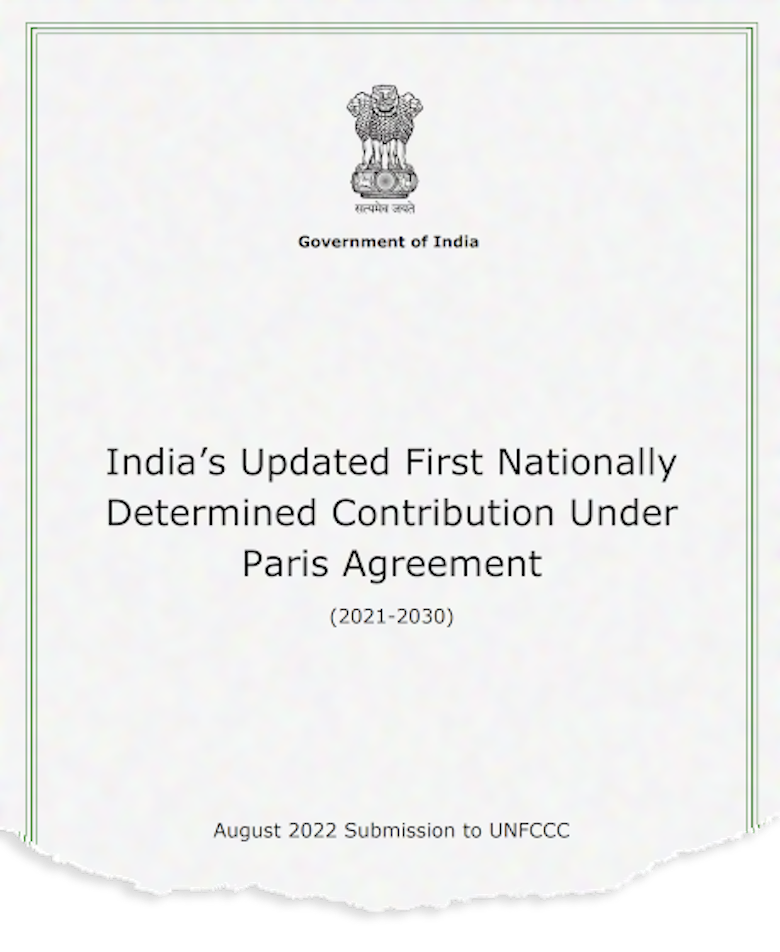
First, India has committed to cutting the emissions intensity of its GDP to 45% below 2005 levels by 2030. To date, there is no globally agreed benchmark to measure this type of target.
An intensity target also gives India the space to avoid an absolute emissions reduction goal, allowing it to continue increasing emissions while growing economically. Its pledge, therefore, depends on total emissions and the country’s GDP in 2030. Other major developing economies, such as China, have used the same metric before.
Second, the country has pledged to “achieve about 50% cumulative electric power installed capacity from non-fossil fuel-based energy resources by 2030”.
An earlier press release released by the Indian government says the goals announced in India’s NDC “do not bind it to any sector-specific mitigation obligation or action”. This language is echoed in a letter from India’s environment minister Bhupender Yadav to UN Climate Change, uploaded along with the NDC submission, but is not in the NDC text.
India’s target for its land and forestry sector remains unchanged from its first NDC:
“To create an additional carbon sink of 2.5 to 3bn tonnes of CO2-equivalent [GtCO2e] through additional forest and tree cover by 2030.”
There is still no further clarity on this sink target and the baseline from which this reduction will be calculated (See Land-use change.)
Non-quantifiable goals in the NDC include Indian prime minister Narendra Modi’s call for a global “movement” centred on individual climate responsibility and “sustainable lifestyles” that he calls “lifestyle for environment” or LIFE.
Another vague 2030 target is to “adopt a climate-friendly and a cleaner path than the one followed hitherto by others at [sic] corresponding level of economic development” – a barb directed at developed countries.
According to the Indian government, the update “translates the ‘Panchamrit’ [which means ‘five nectar’] announced at COP26 into enhanced climate targets”.
However, not all elements announced by Modi in his Glasgow speech have been included in the update. Others have been clarified and reduced in their scope.
The first element of his speech – for India to meet 50% of its “energy requirements” from “renewable energy” by 2030 – has been clarified, as expected, after causing widespread confusion at the time.
It has now been refined into India meeting “about” 50% of its cumulative installed electric capacity from non-fossil sources. By its definition, this includes large hydropower, nuclear and bioenergy sources, along with solar and wind. The NDC makes the goal conditional on the availability of international climate finance.
Day after Modi’s #COP26 speech, still lot of confusion…
— Simon Evans (@DrSimEvans) November 2, 2021
* 50% renewable by 2030 widely interpreted as share of electricity generation but NEA briefing yday suggested *capacity* target (raising existing 40% goal) HT @aruna_sekhar
* is 2070 net-zero GHG or CO2? Big difference…
The NDC drops two specific, quantified targets for emissions and clean energy that had been mentioned in the Panchamrit.
The first was to reduce India’s annual carbon emissions by 1GtCO2 by 2030, while the second was to hit 500 gigawatts (GW) of non-fossil “energy capacity” by 2030.
It is also still not clear whether the 2070 net-zero pledge made by Modi at COP26 refers to carbon dioxide (CO2) or greenhouse gas targets, with the latter being significantly more exacting.
Do India’s new climate pledges raise its ambition?
India’s headline climate target relates to emissions intensity, defined as the total amount of greenhouse gas emitted for each unit of GDP. This means it applies to all sectors of the economy and covers greenhouse gases, such as methane and nitrous oxide, as well as CO2.
India’s updated NDC signals a 10-12 percentage-point increase in its emissions intensity target for 2030 – from 33-35% to 45% below 2005 levels.
Other targets include a 50% share of installed capacity for electricity derived from non-fossil energy sources, up from 40% in the first NDC. This can also be compared with the 50% purely renewable target for India’s “energy” requirements by 2030, as mentioned by Modi in his Glasgow speech.
India’s carbon-sink goal remains unchanged – namely, 2.5-3bn tonnes of CO2e through additional forest and tree cover by 2030. There is still no clarification in the NDC on what baseline this will be calculated from. (See: Land-use Change.)
| Indicators | Targets for 2030 | Progress in 2022 | ||
| First NDC (Oct 2015) | Modi’s COP26 speech (Nov 2021) | NDC update (Aug 2022) |
||
| Emissions intensity of GDP reduction (compared to 2005) | 33-35% | <45% | 45% | <24% between 2005 and 2016** |
| CO2 emission reduction | - | 1GtCO2 per year from 2021 to 2030 | - | - |
| Quantified LULUCF Carbon Sink target | 2.5-3GCO2e through additional forest and tree cover by 2030 | Not mentioned | As pledged in the first NDC | 0.65% or 156MtCO2e increase in 2019 versus the last Forest Survey of 2017 |
| Non-fossil share of electricity generating capacity by 2030, conditional on international finance and technology transfer | 40% | “India will meet 50% of its energy requirements from renewable energy by 2030.” | “about 50%” | 39.9% |
| Installed capacity of non-fossil energy | - | 500 GW non-fossil “energy capacity” by 2030. | - | - |
Meeting the new emissions intensity target will mean progressing more quickly than India has been managing on recent trends. As per the government’s own GHG inventory submissions to UN Climate Change in 2021, India’s emissions intensity has been reducing at a rate of 1-2% annually.
By its own estimates, India reduced the emissions intensity of its economy by 24% between 2005 and 2016, with independent researchers reaching similar conclusions.
According to analysis by the influential non-profit Centre for Science and Environment ahead of COP26, if the annual rate of decline in emissions intensity was raised by an additional 1 percentage point to 2-3% a year, India could potentially reduce its emissions intensity to 39-40% below 2005 levels by 2030.
While India’s absolute and sectoral emissions have been on the rise, the country’s GDP growth rate dropped in 2017 – and through to 2020 – as a result of a series of factors including domestic policies, the Covid lockdown, demonetisation and a range of other factors.
In analysis published by Ideas4India in July 2022, researchers Aman Srivastava and Ashwini Kumar Swain compared India’s 45% emissions intensity target to other countries and modelled projections of emissions and growth.
Adjusting for GDP growth, they found that India’s emissions trajectory between 2005 and 2017 has been “lower than all other south Asian countries, three of the other four BRICS [Brazil, Russia, India, China and South Africa] countries, and three G7 countries”.
They suggest that India’s emissions intensity target is achievable, but they agree that doing so will require faster progress. They write:
“If India continues to grow at a similar rate of 6.5% between 2020 and 2030, then in order to meet the intensity pledge, emissions will only be able to grow at a maximum of 3.1% annually between 2016 and 2030. However, since emissions will have less space to grow proportional to GDP than in previous years, this will require a greater decoupling of emissions from growth than has been achieved in the past.”
Essentially, India’s updated NDC signals a marginal improvement that is already in line with its existing policies, say experts. (See How have India’s new pledges been received). Meeting the target would mean India following a less emissions-intensive path to grow its economy than it has before.
What do India’s pledges mean for its energy and land-use sectors?
Energy
The updated NDC says 50% of India’s installed power capacity will be made up from non-fossil sources by 2030, conditional on the availability of low-cost international finance. This is a 10 percentage-point increase on the first NDC target, which aimed for a 40% share by 2030.
In December 2021, the definition of non-fossil energy (in India’s clean energy target context) was clarified to include large hydropower, nuclear and renewables.
Based on this clarified definition, the Indian government announced that it had already achieved the first NDC target the previous month. India’s cumulative non-fossil installed capacity reached a total of 40.1%, once it included large hydropower and nuclear energy.
As of June 2022, renewables made up 28.3% of India’s installed power capacity, hydro 11.6% and nuclear 1.7%, for a non-fossil total of 41.6% against 58.4% from fossil sources.
In terms of actual generation, the non-fossil share is much lower. In the same month, coal, gas and oil accounted for 73.4% of India’s power generation, with renewables contributing 13.6%, hydropower 9.7% and nuclear 2.7%, for a non-fossil total of 25.9%.
In 2015, India’s Ministry of New and Renewable Energy (MNRE) adopted a target for India to hit 175GW of renewable energy capacity by 2022. In September 2019, on the sidelines of the UN General Assembly in New York, Modi announced that this target “would be increased to much beyond 175GW” by 2022 – and to 450GW by 2030.
According to a report by the International Energy Agency, India’s power sector would have to undergo an “even more profound transformation” to get to 450GW, but “all possible future pathways have one thing in common: high proportions of solar and wind”.
The IEA’s report said this would involve allowing renewables to displace coal power plants locally, alongside reforms to power procurement and tariff rules that currently prioritise coal. It would also involve more accurate real-time solar and wind generation data, plus a more flexible power system.
While the IEA said in 2021 that “India is on the path towards achieving 175 GW”, multiple recent news stories point to the fact that India “will miss” its 2022 deadline to get there. Most recently, a parliamentary committee pointed to issues with the Indian renewables sector’s slow progress versus its promise on paper, while other news coverage has pointed to the sector being plagued by delayed approvals, import duties, “whimsical” policy-making and inappropriate market design.
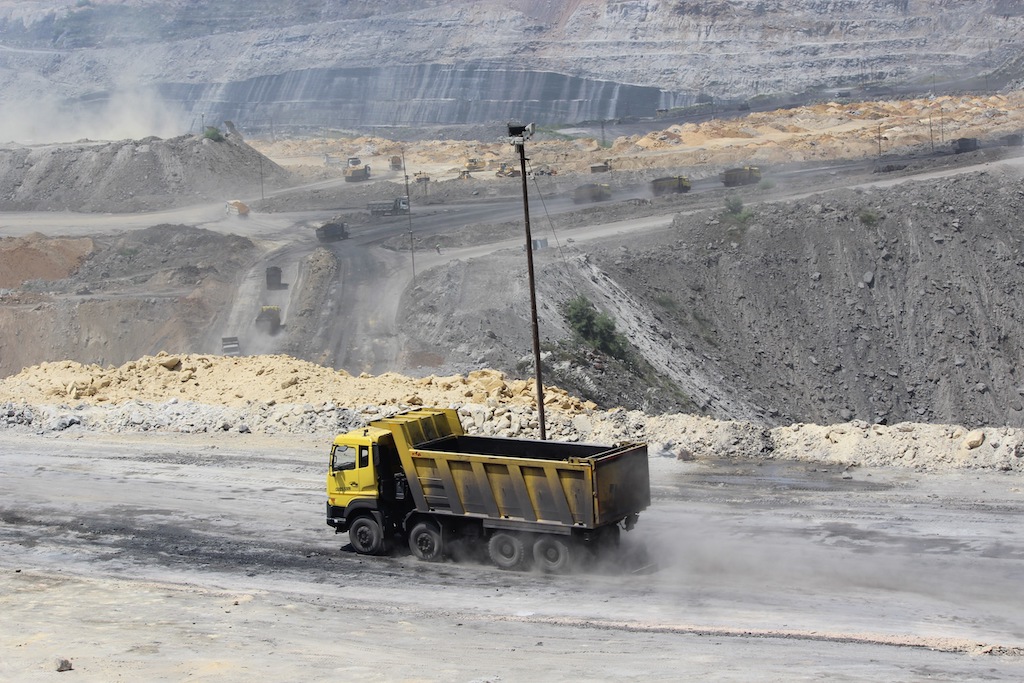
Meanwhile, since 2015, the country has continued to expand its domestic coal production, expanding existing mines while opening up and auctioning new ones.
The Indian government also recently invoked emergency powers to ramp up coal imports, citing a coal shortage. State-run National Thermal Power Corporation and miner Coal India issued tenders for coal imports to private companies, including Adani. Environmental laws were further weakened in light of the fuel crisis.
According to E3G’s Global Energy Monitor, India is currently constructing 31GW of new coal capacity, while its pre-construction coal pipeline (25GW) is the second largest in the world.
At the same time, the country has seen 326GW of coal projects shelved since 2015, for reasons including cheaper renewables, reduced running hours that undermine profitability and challenges securing finance.
According to India’s new draft electricity plan released after the NDC update, India is looking at adding an “additional coal-based capacity of up to 28GW by the financial year 2032, besides the 25GW already under construction.”
Land-use change
There is no change to India’s carbon-sink goal in its updated NDC. According to India’s environment ministry, it is one of five commitments that remains unchanged.

As reported by IndiaSpend, it is still unclear (even to Indian forest authorities) what the target entails or what baseline year it is to be measured against, several years since India submitted its first NDC.
This has not been clarified in the updated NDC, which retains the same language.
In 2019, the Forest Survey of India (FSI) published a special report questioning the term “additional” that appears twice in India’s forest goal and the lack of a clear base year to measure emissions reductions.
The FSI urged India’s ministry for environment, forests and climate change (MoEFCC) to issue a clarification on those “two critical questions, without which strategy for achieving the NDC target cannot be developed”.
According to the FSI report, if 2005 were to be the baseline year, in the most ambitious interpretations of the NDC target, the country’s carbon sink would vary between 30.62 and 34.87bn tonnes of CO2-e cumulatively by 2030.
Separately, the FSI’s metrics for calculating annual forest cover have been questioned by the UN, scientists and national media for their lack of transparency and flawed definitions of what a forest is.
There are long-standing issues with how India measures its forest cover, claiming increases year-on-year, while counting plantations, gardens and other green cover as “forest”.
Moreover, analysis by legal non-profit LIFE India shows that, in 2020, only three out of 367 proposals that involved deforestation were rejected by the MoEFCC and climate ministry, which signed off on 9,434 hectares of forest land being used for industrial purposes.
LONG THREAD: Since 1987, India has assessed its forest cover every two years in its India State of Forest Reports (ISFR), produced by the Forest Survey of India (FSI). The 17th ISFR was released three days ago.
— M D Madhusudan (@mdmadhusudan) January 16, 2022
Here I take a closer look at the entire stack of ISFR reports… pic.twitter.com/kMoqFm0me7
Indeed, India has lost significant amounts of tree cover in recent years, according to forest data platform Global Forest Watch.
The platform says India lost 1m hectares (Mha) of tree cover between 2015 and 2021, equivalent to 508MtCO2e of emissions. Against a 2005 baseline, it says India has lost 1.8Mha of tree cover, representing emissions equal to 899MtCO2e.
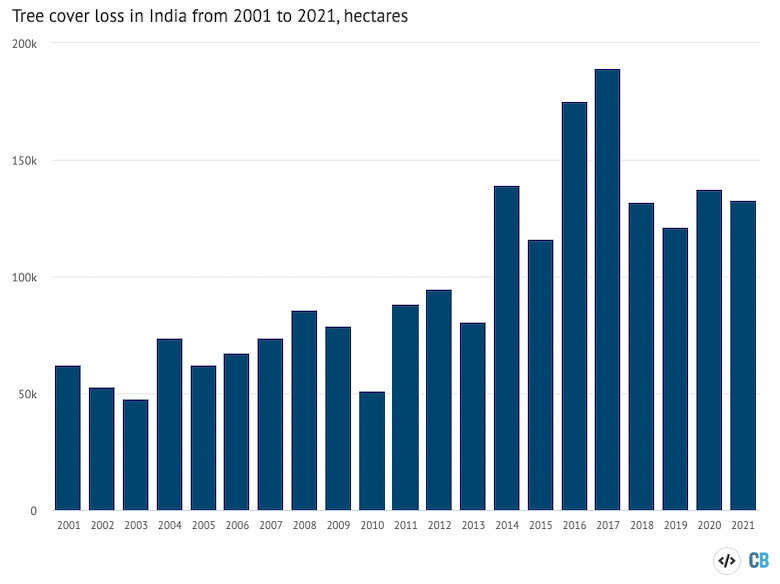
India’s domestic environment and forest policies have also seen steady deregulation, favouring industry and commercial plantations over native, primary forests, as well as the erosion of the rights of Indigenous communities.
During India’s spring heatwave in 2022, experts also pointed to a need for the country to preserve its green cover, as well as ecosystems, such as mangroves and native grasslands, both in cities as well as rural areas to avoid overheating and counter drought impacts.
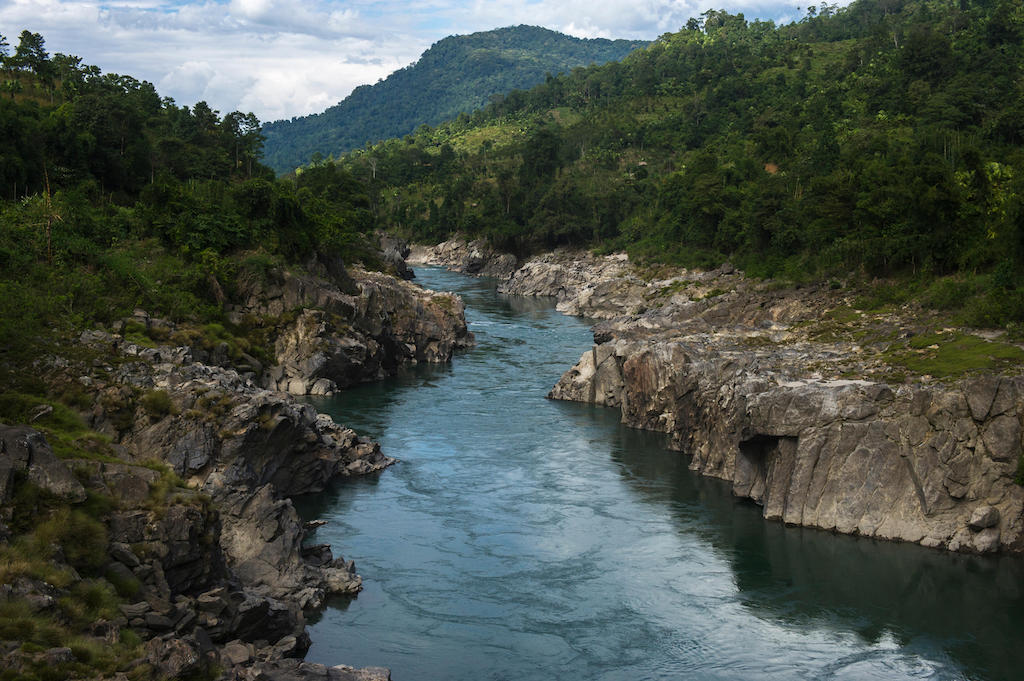
The government’s recent hydropower push to add more than 30GW of new capacity – and 96GW of pumped storage – by 2030, has raised concerns about India’s carbon sink and biodiversity goals, since these large dams tend to be in heavily forested, biodiverse and vulnerable Himalayan regions. According to LIFE’s analysis, hydropower projects accounted for 15% of forest land recommended for clearing by the MoEFCC in 2020.
A recent series of articles for Carbon Copy questions the need for hydropower to be part of India’s 2030 decarbonisation plans, especially given the rise of alternative forms of energy storage.
What are the political considerations behind India’s new climate plan?
The choreography behind India’s updated climate pledge suggests there has been a shift in the political balance of power within the country’s government around climate policymaking.
Several sources, who asked not to be named due to its politically sensitive nature, highlighted the significance of this shift in conversations with Carbon Brief.
Coming up with India’s climate plans, submitting reports to the UN and negotiating its positions internationally has traditionally been the mandate of India’s MoEFCC.
Of all ministries, the MoEFCC’s announcements receive the most international scrutiny, which experts tell Carbon Brief explains its tendency to act conservatively and in line with its long-standing positions.
On the global climate stage, India has historically played a key role in discussions around climate justice, equity and common but differentiated responsibility (CBDR) as an active member of the BASIC, G-77 China and LMDC negotiating groups.
It has pointed to the failure of developed countries to furnish finance or lift what it sees as their “fair share” of the mitigation load necessary to limit warming.
NEW | Analysis: Which countries are historically responsible for climate change? | @DrSimEvans
— Carbon Brief (@CarbonBrief) October 5, 2021
Cumulative fossil fuel & land emissions 1850-2021
🇺🇸 US 509GtCO2
🇨🇳 CN 284
🇷🇺 RU 172
🇧🇷 BR 113
🇮🇩 ID 103
🇩🇪 DE 88
🇮🇳 IN 86
🇬🇧 UK 74
🇯🇵 JP 68
🇨🇦 CA 65https://t.co/9xUpHUKefK
THREAD pic.twitter.com/730aW4GOuY
As the refrain for net-zero by 2050 from rich countries in the run-up to COP26 grew louder, the MoEFCC, energy ministry and Indian experts repeatedly underlined their scepticism of net-zero as a whole, while pushing back on calls for India to commit to such a target.
Three days before COP26, this was still the ministry’s official stance. On 28 October 2021, its climate and environment minister Bhupendra Yadav and union environment secretary RP Gupta “rejected” calls for net-zero. COP26 president Alok Sharma had made two visits to India earlier in 2021 – one in February and another in August – while US climate envoy John Kerry visited in September to urge India to “raise its ambition”.
Things changed dramatically after the G20 summit in Rome on 30 and 31 October, where Modi met Boris Johnson and other world leaders.
This year’s G20 meeting has begun in the beautiful city of Rome.
— Boris Johnson (@BorisJohnson) October 30, 2021
The world’s major economies must take action to end the pandemic and preserve the planet.
Let’s get to work.#G20Italy pic.twitter.com/ULRKFxv4TX
On 1 November, the first day of COP26, Johnson held a special bilateral meeting with Modi soon after the opening ceremony. Outcomes of the talks included a UK India Green Guarantee to “unlock additional lending worth $1bn from the World Bank for green projects in India”, expected to last for up to 25 years.
The very same evening, Modi announced India’s plan to reach net-zero by 2070. According to multiple sources, the target did not have cabinet approval, was led by the Ministry of External Affairs (MEA) and the speech was only shared with the MoEFCC barely hours before it was delivered.
Modi’s five big-ticket “elixirs”:
— Aruna Chandrasekhar (@aruna_sekhar) November 1, 2021
By 2030:
– 500GW non-fossil capacity
– 50% of energy demand to be met by RE
– reduce carbon emissions by 1bn tonnes
– reduce carbon intensity of India’s economy by 45%
– net-zero by 2070 #COP26
India has typically played an active role in the international climate negotiations arena, but dealt its own cards cautiously. It has consistently rejected “legally binding quantitative greenhouse gas mitigation targets for itself”, given its growth-first imperatives and historical negotiating stances on equity and differentiation.
Caution, however, is not a tactic favoured by Modi, who is known to be fond of media spectacle and given to sweeping statements and grand policy moves that sometimes backfire.
With climate assuming greater importance in international diplomatic, financial and media spaces, Modi has been keen to be viewed by the world as a climate leader.
Domestically, as climate-related impacts mount, there could also be political benefits from being seen to do more on the international stage, especially given criticism around his government’s rollbacks of environmental and coal safeguards in recent years.
Modi’s COP26 speech appeared to signify a sea-change in who calls the shots on India’s climate policymaking.
In the past year, many of the decisions and big announcements on external-facing climate policy have come either directly from the prime minister’s office, cabinet or from the MEA, timed with moments of high visibility.
The clarification of Modi’s net-zero speech at COP26 was delivered via an MEA-hosted briefing session.
News of India approving the NDC update also came via a cabinet press release, with FAQs provided by the environment ministry to fill in the gaps.
This illustrates one of the issues with the apparent shift in policymaking responsibilities, with experts telling Carbon Brief that the environment ministry will have to work backwards to translate announcements into reality.
In addition to the shift in political control over India’s climate policy, there has also been a shift in the language being used by politicians and other major figures.
Modi has frequently invoked “climate justice” to describe India’s positions and actions, even as climate justice defenders faced arrest and organisations including Greenpeace India saw their operations fold under financial scrutiny.
Increasingly, the language of climate justice and “decoloniality” has also been adopted by energy moguls, such as Gautam Adani, to criticise rich nations who they perceive as faulting India on its emissions trajectory and forcing it to commit to net-zero targets. In a Times of India story months before COP26, Adani is quoted as saying:
“The economic and industrial might of the West sits on a carpet of carbon soot several centuries deep. A hundred years ago, today’s climate reformers were burning over 800m tonnes of coal – more coal than what India produces today. India accounts for only 3% of the extra carbon in the atmosphere.”
How have India’s new pledges been received?
India’s update to its NDC has received praise from most domestic quarters, including from WRI India for committing to “expanding renewable energy at a time of global energy volatility” and from others for clarifying at least some of the big climate announcements made at COP26 and beyond. However, the widely-cited Climate Action Tracker rating still calls it “insufficient”.
Some Indian analysts described the update as a “politically savvy” NDC, one that is safe and, as one source tells Carbon Brief, “very much in line with the balancing act they have been playing”, but that also gives the country “wiggle room” to up its target.
This is acknowledged in the update, which says that, while “no change in other sections of the document containing existing first NDC is proposed at this stage…India reserves the right to provide further updates as and when required”.
Other experts question the very idea of “ambition” in climate pledges made under the Paris Agreement. The Centre for Policy Research’s Prof Navroz Dubash tells Carbon Brief:
“Whether a country is ambitious or not assumes that we have an agreed set of benchmarks. And we don’t. So de-facto net-zero by 2050 becomes a benchmark, but there’s no reason why every country should [aim for that]. Under the Paris Agreement, we have every country coming up with their own benchmark, a contest where everybody brings their own judge. However, the main value of the Paris pledges are less tied to comparison across countries and more as a way to stimulate progress within countries.”
Dubash believes that India could achieve its intensity target, given that it is consistent with modelling studies based on India’s current policy trajectories and that “there will only be more policies” in the future.
According to him, unlike the EU where strong international targets drive domestic policy “upward”, in countries such as India and China pledges are drafted on the basis of whether they can be met and exceeded based on current climate policy.
For context, in the same week as India announced its NDC update, it also announced amendments to its Electricity Act and a new Energy Conservation Bill, which could herald more privatisation in India’s power distribution sector, fix caps for procurement of renewables and set up India’s domestic carbon market.
In July, India’s power ministry issued a notification which requires electricity distribution companies to draw a minimum share of their total consumption from renewables, of up to 43% by 2030.
To Dubash, the last example illustrates how close the country is to having a domestic generation target for renewables, not just installed capacity.
However, none of these policies are mentioned in the updated NDC. This means that India could potentially over-deliver on its promises, just as it could backtrack from them – but what happens nationally is key, say Dubash and Tuft University’s Tarun Gopalakrishnan.
Dubash, for one, is relieved that there was no quantified target for renewable or non-fossil installed capacity. He says:
“[A quantified] target incentivises and signals capacity addition, but doesn’t actually incentivise or signal the use of these things. And so you keep relentlessly building them, without spending enough time and attention on whether or not you’re going to be using everything you build. You run the risk of stranded assets down the road, whether for renewable energy or coal. We don’t want to get into a situation where you’re not thinking about your entire electricity system, transmission, storage, coal phase down or early coal retirement.”
What Dubash would “really much rather see” as an important climate signal is a non-fossil generation target, even if it is much more modest.
“Nobody is saying 50%, but do 30%, or 40% – whatever the numbers seem to suggest is feasible, but a generation target sends a clear signal that you’re looking at the whole system and the functioning of the whole system in a way that moves you towards renewables.”
Avantika Goswami, programme manager of climate change at thinktank CSE, says there is a “duality” in how CSE views India’s new pledge, from global and domestic points of view.
On one hand, India’s energy demand is set to rise as people grow more prosperous. To have a “half of that potentially be sourced” from non-fossil sources – “despite the pressures of financing and energy security that are currently dominating energy decision-making” – is “commendable”, “ambitious” and in line with the Paris Agreement that states each successive NDC should present a progression.
It is particularly notable given that many developed countries are committing far below their fair share of emission reductions, Goswami says.
Viewed domestically, however, she tells Carbon Brief:
“We know that India can show more ambition in service of its own interests. We are already at about 40% installed capacity of non-fossil sources. The Central Electricity Authority of India’s projections suggest that non-fossil capacity will rise to 62% by 2030. Applying the targets to generation instead would represent greater ambition, raising it from 22% today to 50% in 2030. Removing the 1GtCO2 emissions reduction goal, which was also announced at Glasgow, is another missed opportunity, since it could have provided a clear signal to various sectors, to enable them to peg their own mitigation targets to a quantified national target.”
India’s first NDC was classified as 2C or Paris “compliant” by Climate Action Tracker and in line with its fair shares and historical responsibility.
This was a rating often cited by India’s policymakers as a sign of India’s progress towards its climate goals, versus those of developed economies. In April 2021, power minister RK Singh cited this rating at an IEA ministerial, saying that “we are the only major economy in the world whose actions in energy transition are consistent with keeping the temperature rise below 2C” and that “developed nations should not talk about net-zero”.
In 2021, however, CAT revised its rating based on updates to its methodology, which included not just taking stated country pledges at face value, but evaluating current policies and actions to get there, as well as net-zero targets, forest commitments and finance requests.
This methodology change resulted in a downgrading of India’s pledge to “highly insufficient”. The change was criticised by the Indian government and experts.
In its profile on India, however, CAT points to the fact that India still has “one of the largest coal [power] pipelines in the world” and that it should phase out coal by 2040 to be 1.5C compliant.
Responding to Modi’s Glasgow announcements, CAT changed its ranking for India from “highly insufficient” to “insufficient”, noting that “updated targets will, at most, drive minor reductions in real-world emission reductions.” It said that “further cuts are needed in 2030 emissions to put India on a 1.5C pathway”.
A new study in Nature Climate Change, meanwhile, surveyed 599 negotiators and 230 scientists worldwide. Among a selection of countries “most important for climate mitigation policies”, the study ranked India’s updated NDC as fifth in compliance (meaning the “expert evaluation of the likelihood that the NDC pledge submitted by their home country would be honoured”) and fourth in ambition.
The study’s lead author told Down to Earth:
“India has been pretty careful to not make bold pledges far beyond what the Indian government is confident it can deliver.”
Writing in the Conversation, Gopalakrishnan points out that, while India’s targets are an improvement from its 2015 pledge, “they are largely a continuation of the country’s “business-as-usual” emissions trajectory”.
He adds that, while “a fast-growing country can reduce its emissions per GDP and increase its emissions”, India missed out on the opportunity to spell out its national ambitions in a way that would “attract” the international finance it says it wants.
-
Q&A: What does India’s updated Paris Agreement pledge mean for climate change?




